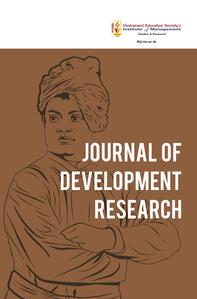
1 Department of Commerce, Bodoland University, Kokrajhar, Assam, India
Creative Commons Non Commercial CC BY-NC: This article is distributed under the terms of the Creative Commons Attribution-NonCommercial 4.0 License (http://www.creativecommons.org/licenses/by-nc/4.0/) which permits non-Commercial use, reproduction and distribution of the work without further permission provided the original work is attributed
Financial inclusion is essential for the effective channelisation of money, allowing individuals to access financial products and services that enhance their financial well-being and contribute to the economic growth of a nation. Governments worldwide are recognising the importance of financial inclusion and are taking initiatives to enhance it. In India, the Pradhan Mantri Jan Dhan Yojana (PMJDY), launched in 2014 stands as a significant effort by the government to boost financial inclusion. This study is an attempt to assess financial inclusion across Indian states and union territories, focusing on three key dimensions: automated teller machines (ATM) penetration, insurance penetration and mutual fund penetration. This study is based entirely on secondary data, sourced from the annual reports of the Reserve Bank of India (RBI), Insurance Regulatory and Development Authority of India (IRDAI), Securities and Exchange Board of India (SEBI), Association of Mutual Funds in India (AMFI) and Unique Identification Authority of India (UIAI). The findings of this study provide valuable insights into the current state of financial inclusion in India and will contribute to effective policy formation aimed at enhancing financial inclusion across Indian states and union territories.
Financial inclusion, accessibility, ATM deployment, insurance penetration
Aziz, F., Sheikh, S. M., & Shah, I. H. (2022). Financial inclusion for women empowerment in South Asian countries. Journal of Financial Regulation and Compliance, 30(4), 489–502.
Chacko, K. T., & Baag, P. K. (2021). Financial Inclusion in India: An approach through FinTech as a solution (No. 463).
Chafa, A., Gupta, P., & Makadi, Y. C. (2023). A comparative analysis of recent efforts on financial inclusion and the policy recommendations of financial inclusion in India and Nigeria. Journal of Namibian Studies: History Politics Culture, 34, 6386–6398.
Dar, A. B., & Ahmed, F. (2021). Financial inclusion determinants and impediments in India: insights from the global financial inclusion index. Journal of Financial Economic Policy, 13(3), 391–408.
Datta, D. (2023). The future of financial inclusion through fintech: a conceptual study in post pandemic India. Sachetas, 2(1), 11–17.
Ghose, S. (2020). Financial inclusion in India: Does distance matter?. South Asia Economic Journal, 21(2), 216–238.
Gupta, S. (2020). An analysis on progress and prospects of financial inclusion in India. Editorial Board, 9(8), 90–94.
Gupta, S., & Thakur, K. S. (2020). Performance evaluation of financial inclusion in India: with special reference to Pradhan Mantri Jan Dhan Yojana (PMJDY). Innovation and emerging trends in business management and information technology. Jiwaji University May, 1–23.
Kanungo, R. P., & Gupta, S. (2021). Financial inclusion through digitalisation of services for well-being. Technological Forecasting and Social Change, 167, 120721.
Kulkarni, L., & Ghosh, A. (2021). Gender disparity in the digitalization of financial services: challenges and promises for women’s financial inclusion in India. Gender, Technology and Development, 25(2), 233–250.
Mndolwa, F. D., & Alhassan, A. L. (2020). Gender disparities in financial inclusion: Insights from Tanzania. African Development Review, 32(4), 578–590.
Panakaje, N., Rahiman, H. U., Parvin, S. R., Kulal, A., & Siddiq, A. (2023). Socio-economic empowerment in rural India: Do financial inclusion and literacy matters? Cogent Social Sciences, 9(1), 2225829.
Pradhan, R. P., Arvin, M. B., Nair, M. S., Hall, J. H., & Bennett, S. E. (2021). Sustainable economic development in India: The dynamics between financial inclusion, ICT development, and economic growth. Technological Forecasting and Social Change, 169, 120758.
Ratnawati, K. (2020). The impact of financial inclusion on economic growth, poverty, income inequality, and financial stability in Asia. The Journal of Asian Finance, Economics and Business, 7(10), 73–85.
Rehman, A. (2020). Innovation and management by regional rural banks in achieving the dream of financial inclusion in India: Challenges and prospects. Marketing and Management of Innovations. DOI:10.21272/mmi.2020.1-18
Sil, N. (2020). Research perspectives on financial inclusion for inclusive growth in India. Asian Journal of Economics, Finance and Management, 304–325.
Singh, K., & Gupta, N. (2020). Financial inclusion in India-A review. Indian Journal of Economics and Development, 16(2), 278–284.
Steffi, I. J., & Balkees, N. (2020). An overview of financial inclusion on poverty alleviation in India. Our Heritage UGC Care Listed Journal, 68(2), 187–196.
Tiwari, C., Goli, S., Siddiqui, M. Z., & Salve, P. S. (2022). Poverty, wealth inequality and financial inclusion among castes in Hindu and Muslim communities in Uttar Pradesh, India. Journal of International Development, 34(6), 1227–1255.
https://uidai.gov.in/images/StateWise_AadhaarSat_Rep_31082023_Projected-2023-Overall.pdf
https://www.amfiindia.com/geographical-spreads
https://irdai.gov.in/annual-reports
https://rbi.org.in/Scripts/StateRegionATMView.aspx
https://www.worldbank.org/en/topic/financialinclusion/overviewJo